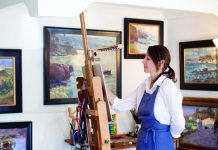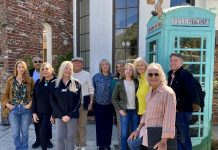Slow art day at Laguna Art Museum

It’s said that the average museum-goer spends about 18 seconds looking at a work of art. How much can one see in that time span? Not much.
Last Saturday Laguna Beach artist Hedy Buzan took a group of museum goers on a leisurely, two-hour tour of the Laguna Art Museum’s exhibition “Excerpts,” comprised of works from its permanent collection.
Buzan hosted Slow Art Day, envisioned as a way to decelerate us and really absorb what we are looking at. To that end, Buzan gave the group of four a list of works to contemplate. But, it was soon discarded and we saw art that we found initially intriguing, repellent, just so-so or loved on first sight.
To start out, Buzan recommended a quick tour of the exhibit before focusing on, say, six paintings that stood out from the pack. “Use a meditative, emotional approach first and then get into details and structure,” she advised.
The group, all well into middle-age, included Jan Powers, a former student of Buzan’s, Ron Sizemore, an amateur watercolorist, Herb Killackey, who came without his artist spouse just for the experience, and this reporter. Our leader is an abstract painter, print maker and multi-media artist who exhibits at the Festival of Arts and at the Sawdust Festival
All grooved on Florence Arnold’s “Black on Red” at first sight. Reaction to her gradations of red into pink topped by black shapes that, after a while, fooled the eye into seeing folded paper, was a collective “wow,” even from Sizemore, who did not express much initial affection for abstract art.
Then again, Laddie John Dill’s untitled installation, consisting of small glass panes strategically inserted into a dune-like mount of sand, elicited ruminations on the impact of art and architecture on the environment, and the origins of glass as sand. “Man is an island onto him…,” mused Sizemore.
Things became more complicated when we pondered Peter Krasnow’s drastic change of style from small, dark, German Expressionistic landscapes to large panels filled with symbols that vexed the group. The radical shift to a glaring palette was another mystery. We reached no conclusions but reveled, much like artists, not in the process of creating art but of looking and interpreting.
“As you look, you interpret with your own life experiences and it does not always matter whether your conclusions match the artist’s intent,” said Buzan.
When we approached a large abstract canvas by Vic Joachim Smith, Buzan urged us to observe before reading a painting’s title. “Looking at titles will predispose one; it can even spoil the effect,” she noted.

This piece, were one to give it said eight seconds, would remain a grisaille (gray on gray) mishmash without rhyme let alone reason. Closer observation suggested homage to world religions and spirituality. A few steps back and squinting revealed (to this writer) a Christ-like head and crucifix, disjointed hands and arms and various faces consumed by rapture throughout. Collectively, the painting was deemed one of the more intriguing in the show.
In a completely different vein, looking at Ruth Eaton Peabody’s “Love,” a loosely brushed portrait of a mother and child and a cat did not elicit much interest until Buzan pointed out an exquisite arrangement of sight lines that both visually and emotionally connected the pair with the carefully articulated cat.
Peabody’s “The Cookbook,” on the other hand elicited comments on narrative, the woman’s expression and the arrangement of subject, table and background eliciting Matisse. Here Buzan cautioned against comparing works with those from other painters. “Find a work’s own merit before delving into possible history,” she suggested.
When she led the group to Chris Wilder’s “UFO Sighting,” all we saw was a bright green canvas with a high, red covered stool placed strategically before it. Torturous examination yielded three tiny red dots on the canvas along with gradations of green and persisting questions of “so what?” Buzan did not let up: We stepped forward, we stepped back, we squinted and we sighed and finally, the sea of green yielded movement. A singular picture plane turned into several and, with some stretching, a universe replete with red invaders could be imagined. Time? About 15 minutes.
This is the third Slow Art Day. The first in 2009 took place in 16 venues. Today there are more than 90. The event is free but relies on museum cooperation and volunteers such as Buzan. Participants sign up online and pay their own museum admissions.




